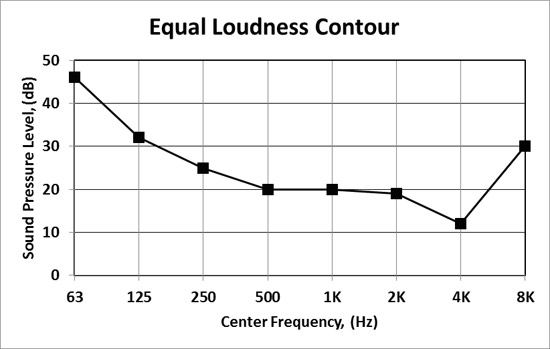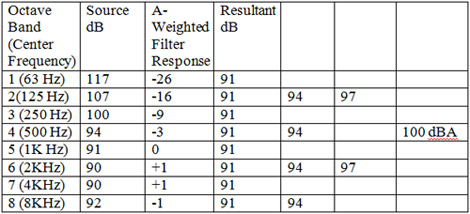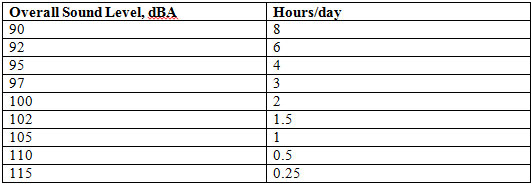Noise Reduction in HVAC Duct Systems
Loudness
Loudness, a subjective measure, is an attribute of auditory sensation. It is a function of frequency and sound pressure level. However, the frequency of a sound will have substantial bearing on how loud the receiver perceives it to be. Equal loudness contours have been developed which show the increase and decrease in sound level energy required at various frequencies for the average human to perceive sound in a particular frequency as sounding just as loud, say, as that of a 20 dB sound pressure level at 1000 Hz.
 |
Loudness is a function of sound pressure and frequency. Provided by Kinetics Noise Control, Inc. |
A-Weighting
Weighting is a useful means of adjusting a linear noise spectrum to closely reflect the human ear response. An A-weighting filter on the sound meter is commonly used to emphasize frequencies from 1000 to 8000 Hz where the human ear is most sensitive, while attenuating very high and very low frequencies to which the ear is less sensitive.
Human beings are so sensitive to sound in the 2,000 Hz to 4,000 Hz levels that A-weighting, the most common weighting system, actually increases those levels to more closely reflect the human ear response. The basis is equal loudness contours. Adjustments are made in all frequencies except 1000Hz. Once adjustments are made, decibel addition can be used to yield a single “A-weighted” sound pressure level (dBA).
Table 9. Example of A-weighting using rule-of thumb guidelines.
 |
Since A-weighting accounts for the sensitivity of human hearing and it is a relatively simple metric, Occupational Safety and Health Administration (OSHA) has adopted it to set limits on noisy work environments. Specific requirements and guidelines may be found in OSHA Standard 29CFR, Part 1910, Subpart G “Occupational Health and Environmental Control.”
Table 10. Federal Noise Limits (OSHA)
 |
|
Table courtesy of Kinetics Noise Control, Inc. |
Duct System Acoustics
In order to determine if a duct system requires additional attenuation, all the duct components along the critical duct path must be analyzed. This analysis starts with the fan sound power levels (per octave band) and ends with the sound absorption or reflection effects of the receiving room.
Design professionals should be aware that there are multiple noise propagation paths that should be considered: the noise that travels through both the supply and return duct system paths, and the airborne noise that radiates away “breaks out” through the walls of the duct into the neighboring spaces.
Fan Noise
Fans generate the primary noise source in HVAC systems. Fan manufacturers can provide laboratory test results for the total sound power levels of the fan that includes the fan inlet, discharge, motor drive train and casing radiated noise. Testing is conducted according to Air-Movement and Control Association (AMCA) Standard 300, “Reverberant and Room Method for Sound Testing of Fans.” AMCA, a trade organization comprising fan, damper and silencer manufacturers, specifies test methods and requirements so that all members use the same rating guidelines. Similar test methods are published by the International Organization for Standardization (ISO) and the American Society for Testing and Materials (ASTM).
Sound level data from fan manufacturers may be either total fan sound power levels or separated into inlet sound power level and discharge sound power levels. The most important data concerns the noise propagating inside and along the duct system paths. If the sound power level is only given as a total sound power level the rule of thumb is to subtract 3 dB from the total fan Lw for each octave band. This is true for both stand-alone fans as well as for packaged air handling units.
Noise from Packaged Air-Conditioning Equipment
Design professionals should obtain manufacturer’s noise data from tests conducted in accordance with Air-Conditioning and Refrigeration Institute (ARI) Standard 260.
Controlling Fan Noise
Fans should be selected to operate near their maximum efficiency. Fans are noisier when they are either oversized and operating under design speed, or undersized and operating above design speed.
Duct system components can both attenuate and generate noise as sound and air propagate through the system. The following discusses some of these more prominent affects.









